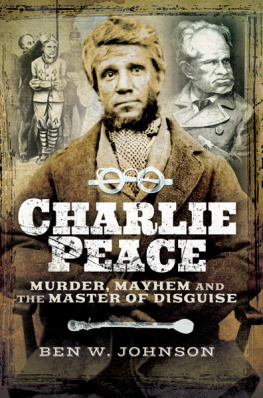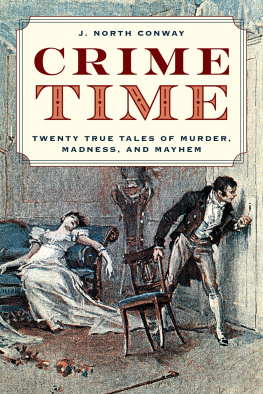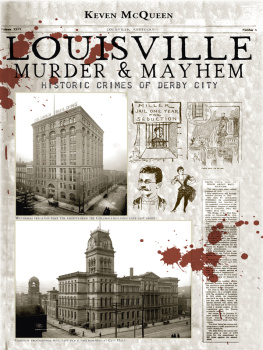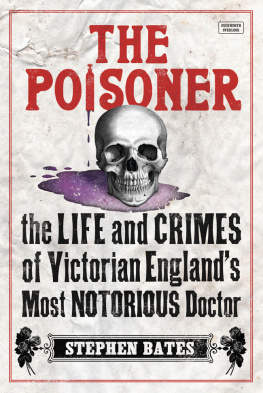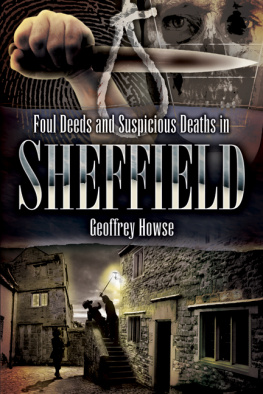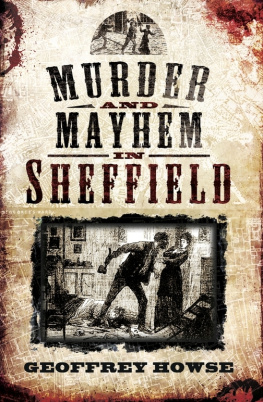For Alison, the love of my life, who will never cease to believe in me; and for my family, who supported me throughout.
My heartfelt thanks will never be enough to show the gratitude I owe to each, and every one, of you.
Also, thanks to Trevor Stockbridge, my fellow adventurer and unofficial chauffeur, and Simon Rodgers, who just wanted to be mentioned in this book.
First published in Great Britain in 2016 by
TRUE CRIME
an imprint of
Pen and Sword Books Ltd
47 Church Street
Barnsley
South Yorkshire S70 2AS
Copyright Ben W. Johnson, 2016
ISBN: 978 1 47386 298 2
PDF ISBN: 978 1 47386 301 9
EPUB ISBN: 978 1 47386 300 2
PRC ISBN: 978 1 47386 299 9
The right of Ben W. Johnson to be identified as the author of this work has been asserted by him in accordance with the Copyright, Designs and Patents Act 1988.
A CIP record for this book is available from the British Library All rights reserved. No part of this book may be reproduced or transmitted in any form or by any means, electronic or mechanical including photocopying, recording or by any information storage and retrieval system, without permission from the Publisher in writing.
Printed and bound in England
by CPI Group (UK) Ltd, Croydon, CR0 4YY
Typeset in Plantin by
CHIC GRAPHICS
Pen & Sword Books Ltd incorporates the imprints of Pen & Sword Archaeology, Atlas, Aviation, Battleground, Discovery, Family History, History, Maritime, Military, Naval, Politics, Railways, Select, Social History, Transport, True Crime, Claymore Press, Frontline Books, Leo Cooper, Praetorian Press, Remember When, Seaforth Publishing and Wharncliffe.
For a complete list of Pen and Sword titles please contact
Pen and Sword Books Limited
47 Church Street, Barnsley, South Yorkshire, S70 2AS, England
E-mail:
Website: www.pen-and-sword.co.uk
Contents
Prologue:
Hard Times in the Steel City
If the people of Sheffield could only receive a tenth part of what their knives sell for by retail in America, Sheffield might pave its streets with Silver.
William Cobbett, Politician,
Journalist and Agriculturalist, 1763-1835
S heffield is one of the five largest cities in England, yet in the realms of British crime, seems to have been a minor player as a setting for tales of murder and depravity. That isnt to say that this northern metropolis hasnt suffered its share of crime, but many would struggle to name an infamous villain hailing from this thriving city. Fleetingly mentioned in a meagre handful of famous cases, Sheffield was the site of Peter Sutcliffes last stand, and the destination to which the wife of Reginald Christie would so often disappear, leaving her husband alone to find new forms of degeneracy on each occasion.
Yet, from this industrial region hails one of the most intriguing, and notorious murderers of the nineteenth century. A man who is still talked about by a handful of scholars and historians; yet is perplexingly unknown to most true crime aficionados outside the South Yorkshire area. His wax effigy was once one of the most visited exhibits in Madame Tussauds Chamber of Horrors, yet his story began to disappear almost as soon as the wax was melted down to create an image of some other terrible, macabre character from the pages of the penny dreadfuls.
The tale itself paints a picture of a physically unusual man with a volatile temper, but with a love for animals, art and music, and who was briefly the most wanted man in Britain. A man who could exhibit traits of both cultural richness and moral bankruptcy almost at the blink of an eye. It is almost a crime itself that the fascinating story of such a villain has been largely allowed to slip, unnoticed and scarcely remembered, from the history books.
To truly know the man, we must get to know his background, and the lifestyle and social factors which led to his rise to grotesque infamy. This is the story of a man who balanced his base acts of cruelty and greed with flashes of criminal genius, and more than his deserved share of good luck. This is a life which is littered with dark twists and turns, and a story which is wastefully slipping away from the urban legend and folklore of not only the nation, but also the history of his home town.
It is in this very town that we begin, but not in our lifetime, or the lifetime of our subject. We must imagine ourselves travelling back to a small patch of land on the banks of a river in Yorkshire.
Sheffield has existed as a settlement ever since its first humble and primitive homes were lovingly built from mud and straw on the banks of the bountiful River Sheaf over a thousand years ago. This was the ideal location for farming, fishing and hunting. It enjoyed everything a community needed to survive in a life as hard and unyielding as the steel which one day would be produced here.
However, despite its natural charms, and unlike some of the other major British cities, Sheffield was a slow developer, and remained a small village until the Norman Conquest. A small castle was built in what is now the thriving city centre, from which the local Saxon inhabitants could be controlled and kept under close observation.
Perhaps there was more to Sheffield than met the eye of its occasional visitors. The building of a castle to govern over such a small community seems such a drastic step by the apparently nervous Normans, that it is reasonable to assume that this was valuable land, and needed to be treated as such.
It is true that the surrounding countryside was a treasure trove of natural resources, and that the sheltered valley surrounded by seven hills made this an ideal outpost in which to settle. But maybe somebody had also dreamt of what this area may one day become? An unbreakable heart of steel and coal; beating in the geographical ribcage of England.
These small settlements slowly began to grow, until the local villages began to rub shoulders with one another, and the villages melted together like molten steel. What began as a single, primitive dwelling had expanded first into a small settlement, then a few small settlements, then a handful of tiny villages, until these villages linked arms and became a town.
It was still a small town; the whole of Norman Sheffield could now nestle comfortably within the boundaries of the modern city centre. Seemingly happy with its new status, and far enough from the more populous towns to bother with all the grandeur and politics of the developing nation, Sheffield continued to grow, but at a rate which suited its humble beginnings.
Some three centuries later, and with the castle reduced to rubble beneath the city centre, it was time for the town to peep out from behind its humble hiding place, and the hard-working residents of this slowly expanding town began to be recognised for their skills, notably in the production of knives.
Another two centuries passed until the Company of Cutlers in Hallamshire was formed to oversee the production of cutlery and weaponry, for which the town was beginning to make its name. Sixteenth century Sheffield collectively slapped itself on the back for being officially the second greatest producer of cutlery in England. Of course, the top prize went to London, as it so often did.
This local talent for producing blades of all sizes and uses was to be the factor that lifted Sheffield from its place as a fairly anonymous town in South Yorkshire, and hoisted it above London as the chief producer of British cutlery. This rise in status was due in no small part to the tireless work of two men. Benjamin Huntsman, who in the 1740s took the process of crucible steel production and raised the standard to beyond the grasp of anywhere else in the world, and his fellow Sheffield resident, Thomas Boulsover, who invented the Sheffield plate, thereby producing the very material that is still in use today, and is unlikely to ever be bettered.
Next page
